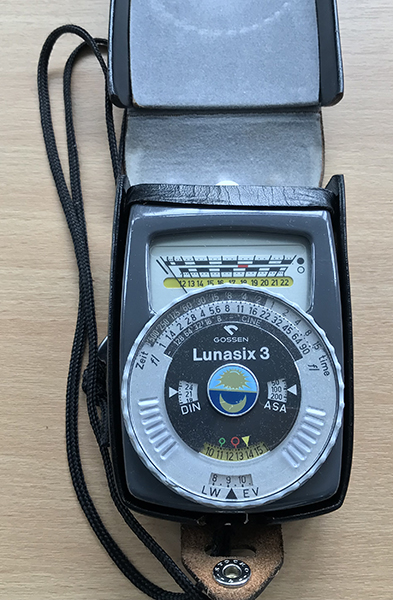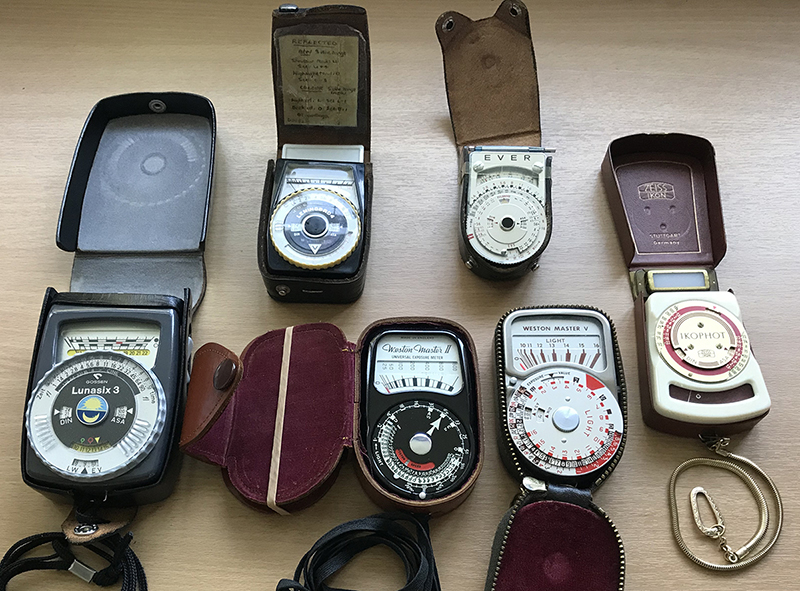The first camera that could afford as a teenager with pocket money from my parents in the late 60s was a humble Kodak Instamatic. It had two fixed brightness settings and used 126 film cassettes (the film format was nominally 26 mm square). I cut my teeth on a first proper film camera by borrowing my father's Voigtlander Bessamatic using 120 roll film. It had no light meter and relied on the small table inside the film cardbox with suggested exposure settings for different types of weather. As any regular amateur photographer will tell you, after a while you can quite accurately judge whether it is a 1/125 f5.6 sort of weather conditions and have read that photojournalists were adept with this sort of judgement.
With some savings made as a paperboy and then as an after hours lab assistant in the high school chemistry laboratory I had enough to buy my first 35 mm camera. Cameras were expensive in the mid 70s and even a modest camera like a German Praktica LTL3 was well over a £100. I opted for a Russian workhorse the Zenith EM with 50/2 lens that could be bought for a more affordable two figure sum. It was so popular that recall waiting weeks for one to be available by mail order.
The Zenith EM had a selenium light meter on the pentaprism panel and a reading from the uncoupled match needle meter on camera top panel had to be transferred to the shutter setting / lens f-stop ring. The meter had to be used with care and invariably shaded it with a hand to prevent the sky giving under exposures. In early twenties was able to upgrade to a black Nikkormat FT3 with Nikkor 50/2 lens. This had through the lens metering using a CdS cell requiring a battery and coupled to the shutter / f stop settings. I still have this camera and remained my workhorse well into the 90s until affordable digital SLRs became available.
My brother Ian and I both enjoy collecting affordable 'retro' harking back to the days before digital technology. As we both have a fond affection to those 'analogue days with scales' our collectibles reflect this. In Ian's case he enjoys radios with analogue tuning dials; he often buys cheap, dirty examples both valve and transistor models and brings them back to excellent cosmetic and working condition (see his article A Passion for Radio - Part 2, January 2013). We also have a few sextants and I have a larger collection of slide rules (see articles shared in the Micscape Lite series).
Vintage light meters have appealing aspects as collectibles: there are a wide variety of makes and models with differing styles, they are compact not requiring much storage, apart from some rarities they are very good value. We opted to just select five from eBay UK and in total these barely reach a three figure sum. These are shared below. There are excellent resources online on most makers and models so links are provided.
Zeiss Ikon Ikophot Rapid, 1950s. Selenium cell. This is our second earliest example made in Stuttgart, Germany and in excellent condition. It is the most tactile of those owned, a finely figured leather case with a snake type chain and elegant clasp. All our meters except one use a selenium sensor not requiring a battery. It is the only match needle type we have where the reading is transferred directly to the shutter / f-stop dials to select the desired exposure. A disadvantage of this design is that it only has a singe sensitivity setting, the others below can switch between two meter sensitivities extending the range of lighting that can be measured. The range has been well chosen though with an EV range to cater for most subjects.
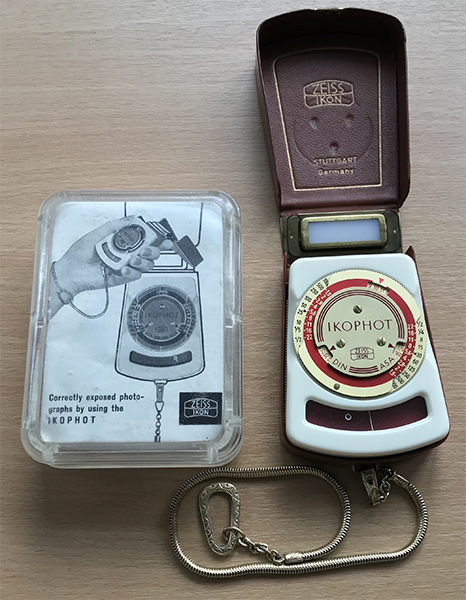
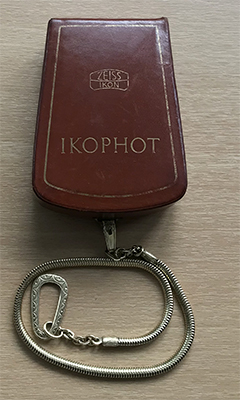
Leningrad 4. Selenium cell. Below left. This does not form part of the recent collectibles as was bought for supporting my photography in the late 70s. Like many meters of the time a white diffuser could be placed over the sensor to take an incident light reading, i.e. light shining from the source onto the subject rather than light reflected off the subject (the Ikophot above has one clipped into the case). This has many advantages which photographers will be very aware of. My Zenith EM and later Nikkormat could not take incident light readings. This Russian basic meter was again the most affordable at the time. Note how the leather case just folds out from the front for ease of use, an ergonomic design a famous maker below did not implement. A sliding knob on the right displays the more sensitive scale allowing more light to reach the sensor. The camerapedia.fandom.com (advert heavy) website describes and illustrates range and notes this model was introduced in 1968.
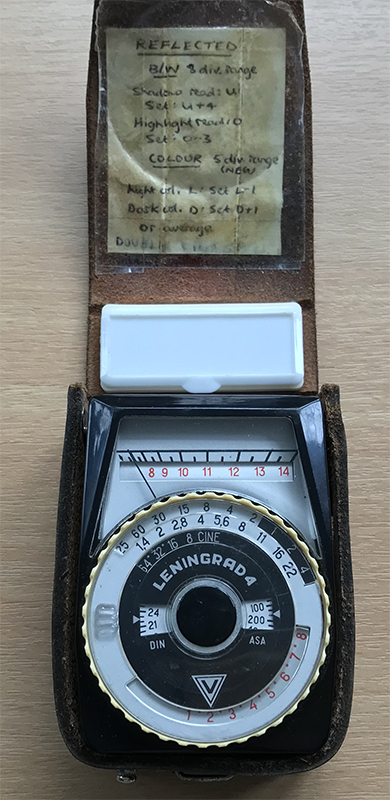
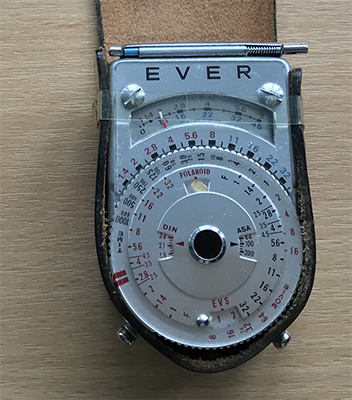
Ever NE-3. Selenium cell. Above right. This was made in Tokyo, Japan and the smallest owned. With its metal case it is well made and heavy for its size but almost reaching a size where it is less ergonomic to use as the scales and dials are smaller. In the lower sensitivity range a metal plate with thin slit is over the sensor. Pushing the hinged rod releases this for the higher sensitivity scale. Like the Leningrad it has a leather top flap that folds down at the front. I haven't found out much information on this maker to date.
Weston Master II model S141/735. Selenium cell. Sangamo Weston Ltd, England were one of the top makers and their Weston Master series became one of the iconic professional meters amongst photographers with a website www.westonmeter.org.uk devoted to the range. This site notes the Master II was introduced in 1946 in the US and later in England. This example in black enamel finish and large scale display in fitted leather case oozes professionalism. The higher sensitivity scale is set by manually unclipping the perforated disc over the microlens sensor cover. The fold back leather case front and back neither my brother nor I think is very ergonomic for regular use, although better than the Master V below!
This had additional dial features such as settings for halving and doubling the exposure and also for setting an exposure if the metre was reading either the darkest or lightest area of the scene, the 'U' and 'O' markers. Another feature of the Weston range which Ian and I question is the very cluttered f-stop and speed settings—smaller than half a stop, the smallest change in camera exposure typically taken.
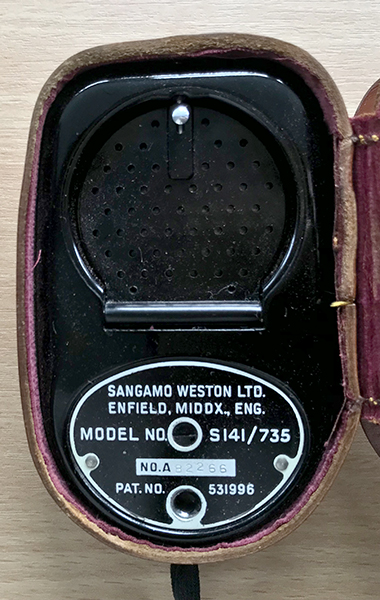
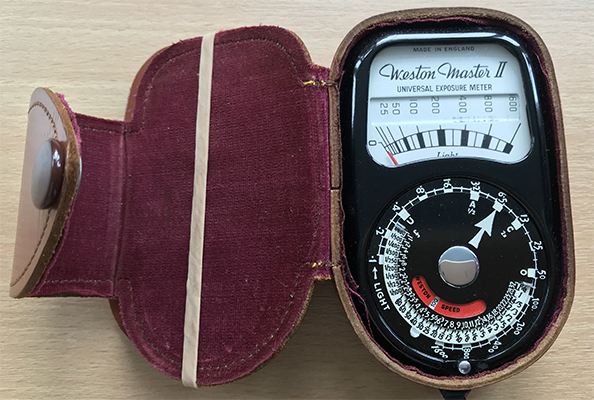
Weston Master V model S461.5. This is one of the most famous models, the dedicated website noting that it was only made in England and between 1963 - 1972. The case design for this model seems even less ergonomic than the Master II. There is no flap for the sensor, the unit has to be removed from its case to expose the sensor window, which does not make it amenable for regular use and case protection in between shots. This example is fully boxed with manual and the incident light diffuser (Invercone) in its own leather wallet.
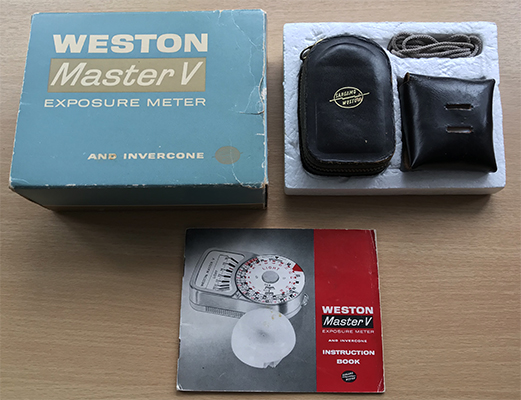
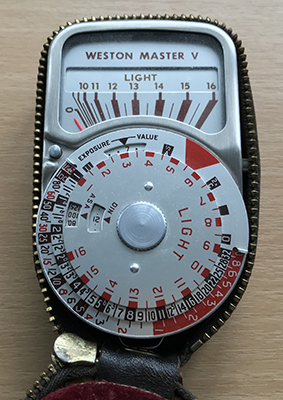
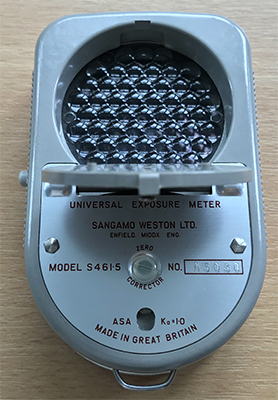
Gossen Lunasix 3. German 1966. This is the only light meter with CdS sensor of those owned and is by far the most sensitive. It is also the largest as can be seen by the groupshot below. The shutter speed range is 1/4000 - 8h, ASA 0.8 - 25000, f1 - f90. The scales are changed with a rocker switch on the right. It has the most ergonomic incident light cone, a small dome that slides across the small sensor window. This has the sensible fold down leather flap. Gossen like Sangamo Weston were one of the leading makers and the former still making light meters today. The splendid Ollinger's Light Meter Collection website has a page devoted to the model also known as the Luna Pro. Also see the camera-wiki.org entry.
Light meters can still be bought and some models do still have analogue displays and others with LCDs. Sekonic and Gossen are two makers with a variety of models. Many are for flash use where in a professional studio taking accurate light readings are essential, the meter linked to the flash system to trigger them.
